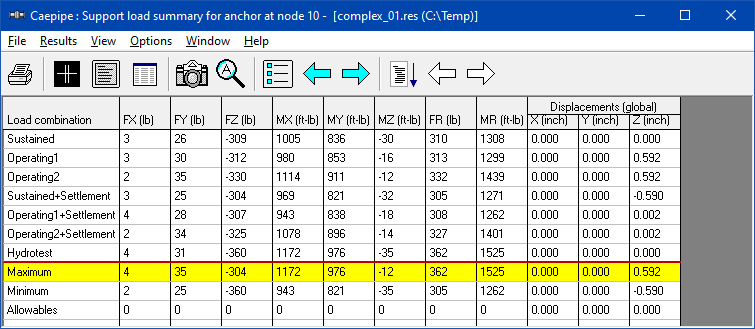Generic Support
A generic data type called Generic support” is available to define a complex support fitting for which the support stiffnesses are obtained from an external source, using a reduced 6x6 stiffness matrix. An example would be a support assembly as shown below.
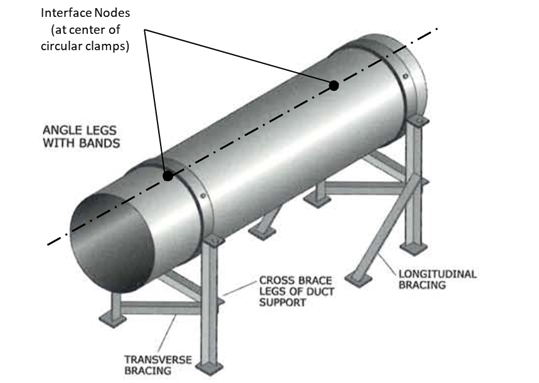
A reduced 6x6 stiffness matrix representative of this support at a single interface node (as shown in figure above) will first need to be arrived at using any general purpose FEA software package (such as ANSYS, NASTRAN, etc.) Then, those stiffness values representing the support assembly can then be input into CAEPIPE model for further analysis.
“Generic Support” is input by typing “ge” in the Data column or selecting “Generic Support” from the Data Types dialog.
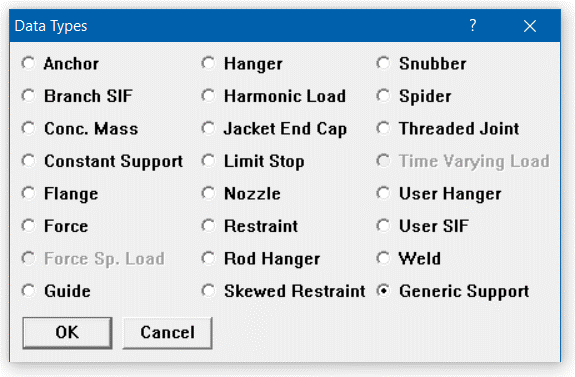
Since the reduced 6x6 stiffness matrix representing the generic support is always a symmetric matrix, only the upper triangular stiffness values need to be input, with the diagonal terms having positive non-zero values. Diagonal terms are never zero or left blank. Off-diagonal terms can be zero, positive or negative values.
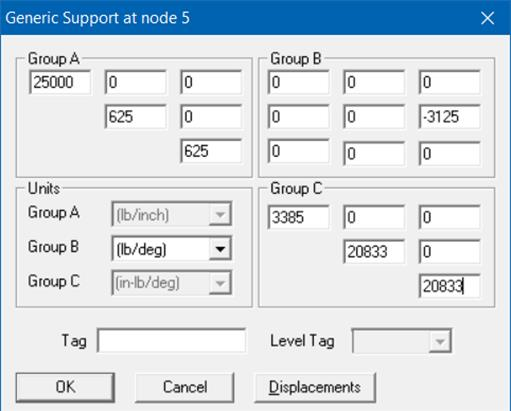
Units for Groups A and C are controlled centrally through the Units command (Ctrl+U in Layout window). Units for Group B need to be set in this dialog.
The Stiffnesses in the Groups A, B and C are to be computed in Global Coordinate System and entered.
The fields in Group A are translational stiffnesses. The fields in Group C are rotational stiffnesses.
The fields in Group B are the coupling stiffnesses. For example, a lateral force at the end of a Cantilever beam produces not only the displacement in the direction of that force, but also a rotation. Similarly, a moment at the end of a Cantilever beam produces not only the rotation in the direction of that moment, but also a lateral displacement.
Each stiffness field in the dialog is editable. The default “rigid” stiffness is shown for all the diagonal terms. If you have a stiffness value for any of these including the off-diagonals, enter them here (ensure units integrity). Graphically, the support is shown as a solid block (at node 330 in the next figure).
.Displacements.
The dialog for Specified Displacements at a Generic Support is shown below. Displacement fields will be enabled or disabled automatically depending upon the load cases defined.
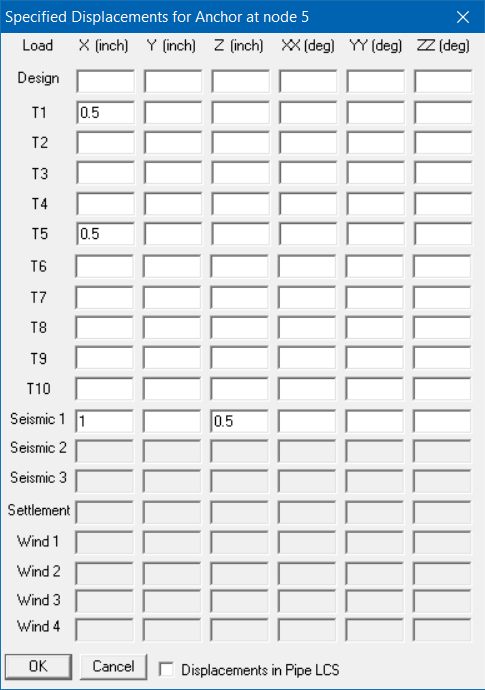
At a generic support, three types of translations and/or rotations in the global X, Y and Z directions may be specified as listed below.
1. Thermal displacements (up to 10 sets can be specified, one each for thermal loads T1 through T10). Applied only to the corresponding Expansion and Operating load cases.
2. Seismic displacements (Seismic 1, 2 and 3) are available for all codes. Solved as a separate internal load case, the results of which are added absolutely to the corresponding static seismic load cases. For response spectrum analysis, only results from Seismic 1 displacements are added absolutely to the response spectrum load.
3. Wind displacements (up to 4 sets can be specified, one each for each of the Wind loads Wind 1 through Wind 4). Applied to the corresponding Wind load cases.
4. For Piping Code = NONE, Specified Displacement results for Seismic 1 and Wind 1 load cases are “Algebraically” added to the results from all other load cases.
You may specify a displacement only if you also specify a corresponding non-zero or rigid stiffness in that degree of freedom, i.e., the corresponding stiffness should not be left blank.
Check “Displacements in LCS” if you want to enter movements in the local coordinate system. These local movements are transformed into the global coordinate system and displayed in results.
Settlement
For certain piping codes (ASME B31.1, ASME Section III Class 2, ASME NM.1, RCC-M, EN 13941 and EN13480), an anchor settlement, which is a single non-repeated movement (e.g., due to settlement of foundation), may be specified. This is applied to the Settlement load case. For those codes that do not have a provision for settlement (like B31.3), specify the settlement as a thermal displacement (which tends to be a conservative approach) for one of the temperature load and define that temperature as equal to reference temperature.
For EN13941-1, specified displacements input as Settlement are included in Sustained load case.
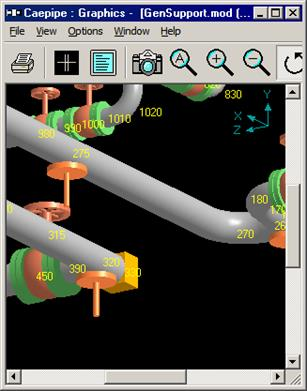
Displacements, support loads and support load summaries are shown for this support type.
